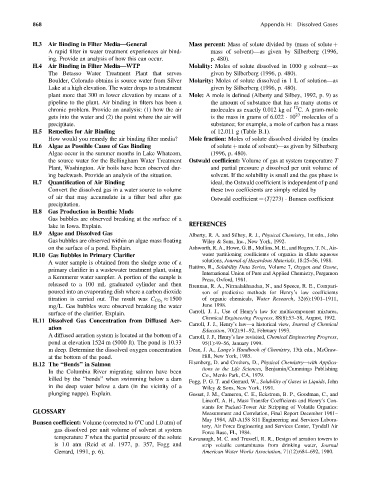Page 913 - Fundamentals of Water Treatment Unit Processes : Physical, Chemical, and Biological
P. 913
868 Appendix H: Dissolved Gases
H.3 Air Binding in Filter Media—General Mass percent: Mass of solute divided by (mass of solute þ
A rapid filter in water treatment experiences air bind- mass of solvent)—as given by Silberberg (1996,
ing. Provide an analysis of how this can occur. p. 480).
H.4 Air Binding in Filter Media—WTP Molality: Moles of solute dissolved in 1000 g solvent—as
The Betasso Water Treatment Plant that serves given by Silberberg (1996, p. 480).
Boulder, Colorado obtains is source water from Silver Molarity: Moles of solute dissolved in 1 L of solution—as
Lake at a high elevation. The water drops to a treatment given by Silberberg (1996, p. 480).
plant more that 300 m lower elevation by means of a Mole: A mole is defined (Alberty and Silbey, 1992, p. 9) as
pipeline to the plant. Air binding in filters has been a the amount of substance that has as many atoms or
12
chronic problem. Provide an analysis: (1) how the air molecules as exactly 0.012 kg of C. A gram-mole
gets into the water and (2) the point where the air will is the mass in grams of 6.022 10 23 molecules of a
precipitate. substance; for example, a mole of carbon has a mass
H.5 Remedies for Air Binding of 12.011 g (Table B.1).
How would you remedy the air binding filter media? Mole fraction: Moles of solute dissolved divided by (moles
H.6 Algae as Possible Cause of Gas Binding of solute þ mole of solvent)—as given by Silberberg
Algae occur in the summer months in Lake Whatcom, (1996, p. 480).
the source water for the Bellingham Water Treatment Ostwald coefficient: Volume of gas at system temperature T
Plant, Washington. Air boils have been observed dur- and partial pressure p dissolved per unit volume of
ing backwash. Provide an analysis of the situation. solvent. If the solubility is small and the gas phase is
H.7 Quantification of Air Binding ideal, the Ostwald coefficient is independent of p and
Convert the dissolved gas in a water source to volume these two coefficients are simply related by
of air that may accumulate in a filter bed after gas Ostwald coefficient ¼ (T=273) Bunsen coefficient
precipitation.
H.8 Gas Production in Benthic Muds
Gas bubbles are observed breaking at the surface of a
lake in Iowa. Explain. REFERENCES
H.9 Algae and Dissolved Gas Alberty, R. A. and Silbey, R. J., Physical Chemistry, 1st edn., John
Gas bubbles are observed within an algae mass floating Wiley & Sons, Inc., New York, 1992.
on the surface of a pond. Explain. Ashworth, R. A., Howe, G. B., Mullins, M. E., and Rogers, T. N., Air-
H.10 Gas Bubbles in Primary Clarifier water partitioning coefficients of organics in dilute aqueous
A water sample is obtained from the sludge zone of a solutions, Journal of Hazardous Materials, 18:25–36, 1988.
Battino, R., Solubility Data Series, Volume 7, Oxygen and Ozone,
primary clarifier in a wastewater treatment plant, using
International Union of Pure and Applied Chemistry, Pergamon
a Kemmerer water sampler. A portion of the sample is
Press, Oxford, 1981.
released to a 100 mL graduated cylinder and then Brennan, R. A., Nirmalakhandan, N., and Speece, R. E., Compari-
poured into an evaporating dish where a carbon dioxide son of predictive methods for Henry’slaw coefficients
1500 of organic chemicals, Water Research, 32(6):1901–1911,
titration is carried out. The result was C CO 2
mg=L. Gas bubbles were observed breaking the water June 1998.
surface of the clarifier. Explain. Carroll, J. J., Use of Henry’s law for multicomponent mixtures,
Chemical Engineering Progress, 88(8):53–58, August, 1992.
H.11 Dissolved Gas Concentration from Diffused Aer-
Carroll, J. J., Henry’s law—a historical view, Journal of Chemical
ation
Education, 70(2):91–92, February 1993.
A diffused aeration system is located at the bottom of a Carroll, J. J., Henry’s law revisited, Chemical Engineering Progress,
pond at elevation 1524 m (5000 ft). The pond is 10.33 95(1):49–56, January 1999.
m deep. Determine the dissolved oxygen concentration Dean, J. A., Lange’s Handbook of Chemistry, 13th edn., McGraw-
at the bottom of the pond. Hill, New York, 1985.
H.12 The ‘‘Bends’’ in Salmon Eisenberg, D. and Crothers, D., Physical Chemistry—with Applica-
tions to the Life Sciences, Benjamin=Cummings Publishing
In the Columbia River migrating salmon have been
Co., Menlo Park, CA, 1979.
killed by the ‘‘bends’’ when swimming below a dam
Fogg, P. G. T. and Gerrard, W., Solubility of Gases in Liquids, John
in the deep water below a dam (in the vicinity of a Wiley & Sons, New York, 1991.
plunging nappe). Explain. Gosset, J. M., Cameron, C. E., Eckstrom, B. P., Goodman, C., and
Lincoff, A. H., Mass Transfer Coefficients and Henry’s Con-
stants for Packed-Tower Air Stripping of Volatile Organics:
GLOSSARY Measurement and Correlation, Final Report December 1981–
May 1984, AD-A158 811 Engineering and Services Labora-
Bunsen coefficient: Volume (corrected to 08C and 1.0 atm) of
tory, Air Force Engineering and Services Center, Tyndall Air
gas dissolved per unit volume of solvent at system
Force Base, FL, 1984.
temperature T when the partial pressure of the solute Kavanaugh, M. C. and Trussell, R. R., Design of aeration towers to
is 1.0 atm (Reid et al. 1977, p. 357, Fogg and strip volatile contaminants from drinking water, Journal
Gerrard, 1991, p. 6). American Water Works Association, 71(12):684–692, 1980.

